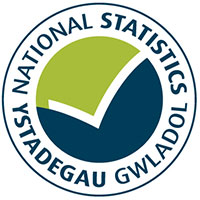Data on the number of households applying to local authorities for housing assistance under the Housing Wales Act 2014 and the number of homeless households in temporary accommodation for April 2017 to March 2018.
This is not the latest release in the series: Homelessness statistics
Main points
Between 2016-17 and 2017-18, there was a small decrease in the number of households threatened with homelessness. However, both the number of households assessed as homeless and the number assessed as unintentionally homeless and in priority need increased.
Homelessness prevention
- Between 2016-17 and 2017-18 the number of households threatened with homelessness within 56 days decreased by 2% to 9,072 households.
- Homelessness was successfully prevented for at least 6 months in 66% of cases (6,021 households). This was up from 62% in 2016-017.
- In 15% of cases prevention was unsuccessful and other outcomes accounted for the remaining 18%. This compares with 18% and 20% respectively in 2016-17.
- For the 6,021 households where homelessness was prevented, a third were able to stay in their own home and two thirds secured alternative accommodation.
Relief of homelessness
- Households assessed as homeless and owed a duty to help secure accommodation increased by 3% on the previous year to 11,277.
- In 41% of cases, the local authority successfully helped to secure accommodation that was likely to last for 6 months. For 4,143 households (37%) the local authority was unsuccessful in securing such accommodation. These were similar to the proportions recorded in 2016-17.
- Of the 4,653 households successfully helped, 30% secured accommodation in the social sector and 30% in the private sector. 23% secured supported accommodation, 9% with family, friends or returned home and 8% secured other accommodation.
Priority need
- The number of households assessed to be unintentionally homeless and in priority need was 7% higher than the previous year at 2,229 households.
- The most common category of priority need was the presence of dependent children or pregnant woman (45%).
- 78% of all households assessed as unintentionally homeless and in priority need accepted an offer of permanent accommodation (down from 81% in 2016-17).
Households in temporary accommodation
- At the end of March 2018, there were 2,052(r) households in temporary accommodation, up by 2%(r) on the previous year.
- Private sector accommodation continued to be the main form of temporary accommodation used. It accounted for 38%(r) of households in temporary accommodation at the end of March 2018 compared with 39% a year earlier.
- At the end of March 2018, there were 243 households in bed and breakfast accommodation a considerable increase from 189 a year earlier. Of these, 30 households (13%(r)) were families with children.
Notes
The Housing Act (Wales) 2014 included changes to statutory homelessness legislation which were introduced on 27 April 2015. The data shown in this headline and report are not comparable with the statutory homelessness data published for 2014-15 or earlier years due to the legislative changes.
Additional information is available within the release and accompanying Quality report.
Revision note
This release has been revised following receipt of revised figures for homeless households in temporary accommodation as at 31 March 2018 for one local authority.
Reports

Homelessness, April 2017 to March 2018 , file type: PDF, file size: 2 MB
Contact
Judith David
Telephone: 0300 025 5055
Email: stats.housing@gov.wales
Rydym yn croesawu galwadau a gohebiaeth yn Gymraeg / We welcome calls and correspondence in Welsh.
Media
Telephone: 0300 025 8099
Rydym yn croesawu galwadau yn Gymraeg / We welcome calls in Welsh.

